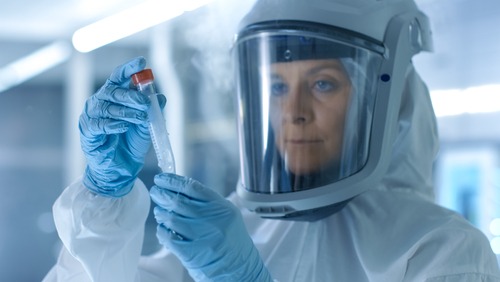
The BioWatch Program, established by Congress in 2003, transferred to the U.S. Department of Homeland Security’s Countering Weapons of Mass Destruction (CWMD) office in 2018 with a whopping budget averaging $76 million per fiscal year from 2018 to 2020.
According to BioWatch officials, the program operates the nation’s only biodetection system, which is intended to detect potential biological agents, identify the agent used, and share information with stakeholders to then initiate emergency response activities — basically serving as America’s early biothreat warning system.
But according to an audit released by the Department of Homeland Security (DHS) Office of the Inspector General (OIG), BioWatch is not operating a nationwide early warning system, and without implementing changes to the program, it warned that the United States’ ability to prepare for, detect and respond to potential bioterrorism attacks are impeded and could result in a significant loss of human life.
The CWMD office heard the message loud and clear and has responded to the audit with plans to meet OIG’s recommendations for improving the BioWatch Program.
Specifically, the OIG audit — entitled Biological Threat Detection and Response Challenges Remain for BioWatch — was done to determine to what extent the BioWatch Program’s information sharing ensures nationwide readiness in response to biological terrorism threats.
What the audit found is that the program’s “biological detection equipment is located in just 22 of 50 states (44 percent), which leaves 28 states without coverage.” The reason? The audit blames the issue on the fact that BioWatch has not reassessed its strategic posture and designated locations needing coverage since the program’s inception in 2003.
At the same time, BioWatch equipment in 34 of its 35 U.S. jurisdictions did not always collect the air samples needed to test for biological threats because the equipment was not secured to prevent unplugging or security breaches, OIG says in the audit.
Such daily collections “are critical to program operations because the samples obtained from the filters allow” information sharing across the BioWatch jurisdictions on whether a biological agent has been released.
BioWatch’s information sharing abilities are further limited because the program monitors and detects just six of 14 (roughly 43 percent) biological agents known from the air filter samples to be threats, largely because the program has not updated its biological agent detection capabilities with the most-current 2017 threat assessment results. “Therefore, it does not comprehensively monitor and detect all biological agents known to be threats,” OIG says.
Also, as of 2018, BioWatch stopped conducting routine full-scale exercises with its jurisdictions in preparation for a potential bioterrorism attack. According to BioWatch officials, this occurred because CWMD leadership directed BioWatch to no longer conduct these exercises, leaving each jurisdiction discretion to perform its own exercises.
“Such exercises,” OIG says, “are a key component of national preparedness against a bioterrorism attack. Without BioWatch conducting routine full-scale exercises with its jurisdictions, it is difficult to gauge the nation’s readiness to respond to a bioterrorism attack.”
In its audit, OIG makes four recommendations on how CWMD could improve the BioWatch Program:
- Conduct risk assessments of BioWatch’s posture and align its capabilities with the program’s mission.
- Revise and update BioWatch cooperative agreements to ensure physical security of all CWMD portable sampling unit equipment throughout all BioWatch jurisdictions.
- Utilize the most recent threat assessment to enhance biological agent detection capabilities to respond to the most up-to-date threats.
- Conduct routine full-scale exercises and share the after-action reports with all stakeholders to improve nationwide information sharing and preparedness.
CWMD plans
According to the audit, CWMD has agreed to all four recommendations and emphasized to OIG that BioWatch “is integral to CWMD’s mission.” The agency also plans to “promptly resolve the issues identified in the report.”
For instance, regarding the first OIG recommendation, CWMD said it will have the Los Alamos National Laboratory conduct a new assessment to assist BioWatch with optimizing its defense against bioterrorism and plans to submit it to OIG by Sept. 30.
Likewise, in response to the second OIG recommendation, CWMD said that BioWatch will work closely with the DHS Grants Office and the Office of General Counsel to develop appropriate language to be included in cooperative agreements that would strengthen security for the portable sampling units.
“A long-term schedule for routine revisions and updates will be included in the BioWatch Management Plan,” with an estimated completion date set for March 31, CWMD said.
On the third recommendation, CWMD said it recently completed a threat assessment that includes biological threats and it will coordinate with federal, state and local partner agencies to further assess the risks of specific pathogens to determine what additional changes to BioWatch agents are appropriate, the audit says. The estimated completion date is Dec. 31.
Finally, on recommendation four, CWMD plans to share an after-action report by April 30 with OIG on full-scale exercises held in February that included biological threats. Additionally, CWMD’s Training and Exercise Division will develop a management plan that includes a five-year exercise schedule for BioWatch to ensure jurisdictions exercise their capabilities on a periodic basis and that lessons learned are captured and shared.
OIG called CWMD’s planned actions “responsive to the intent” of each recommendation, but said the recommendations will remain open until CWMD provides the promised information.




